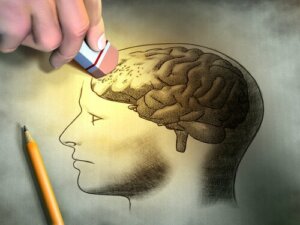Frontotemporal Dementia: Symptoms, Diagnosis, and Treatment

When people hear the word “dementia”, they usually think about something that only affects older adults. However, there are several different types of dementia that affect different groups of people. Some of them can affect younger people, such as early-onset Alzheimer’s and frontotemporal dementia. The latter is the subject of today’s article.
Frontotemporal dementia, or frontotemporal lobar degeneration, is a generic term that refers to a group of uncommon disorders that primarily affect the frontal and temporal lobes of the brain. These areas are associated with personality, behavior, and language and are also areas that tend to lose neurons.
Some people with this kind of dementia experience drastic personality changes and behave in socially unacceptable ways. They might also become very impulsive, emotionally indifferent, or lose abilities related to language or movement. The average age of onset is between 40 and 45 years.
Frontotemporal dementia is the second-most common form of dementia among relatively young adults.

Frontotemporal dementia
In patients with frontotemporal dementia, their frontal lobes contract or become atrophied. Depending on the particular area of the brain that the disease affects, the signs and symptoms vary.
It’s important to note that doctors often misdiagnose frontotemporal dementia as a psychiatric issue or Alzheimer’s disease. However, as we mentioned above, one more obvious sign of this kind of dementia is that it appears at an earlier age.
Researchers haven’t identified one single cause of this type of dementia, but they have some ideas. For example, some people develop abnormal protein structures in their brains called “Pick bodies”. These structures play an important role in this disorder because they directly affect brain functioning.
That being said, researchers still don’t know why certain people develop these proteins or how to prevent them. Experts haven’t been able to identify other risk factors that could help prevent this kind of dementia.
Frontotemporal dementia symptoms
The signs and symptoms of frontotemporal dementia can vary greatly from person to person. Researchers have identified several sets of symptoms that tend to manifest together and are dominant in groups of people with the disease.
Behavioral changes
The most common signs and symptoms of frontotemporal dementia involve extreme mood and personality changes. Here are some of the most characteristic:
- Inappropriate actions.
- Apathy, a lack of motivation or desire.
- Problems with language and speech.
- A loss of empathy and other interpersonal skills.
- Changes in diet and overeating.
- Lack of judgment and inhibition.
- A lack of awareness about their changes in behavior or thoughts.
- Compulsive and repetitive behavior.
- A decrease in personal hygiene habits.
- Oral exploration and consumption of inedible objects.

Changes in speech and language
Two types of primary progressive aphasias fall into the frontotemporal dementia category. They’re semantic dementia and grammatical dementia.
- Semantic dementia or semantic variant primary progressive aphasia. This is the presence of anomia (difficulty naming objects). In fact, people with this condition replace a specific word for another more general one and often even lose their knowledge of the meaning of the word.
- Agrammatic progressive aphasia. This primary progressive aphasia is characterized by halting and shaky speech. Individuals with this condition generally have poor written and spoken grammar.
Movement disorders
The least common subtypes of frontotemporal dementia is characterized by movement problems. These problems are similar to those associated with Parkinson’s disease or lateral amyotrophic sclerosis. These are some of the signs and symptoms:
- Tremors.
- Muscle weakness.
- Difficulty swallowing.
- Muscle spasms.
- Poor coordination.
- Stiffness.
Frontotemporal dementia diagnosis
No single test can identify frontotemporal dementia as such. That’s why doctors try to identify certain characteristics and exclude other possible causes.
This type of dementia, as we mentioned above, can be difficult to diagnose. That’s especially true in the early stages since the symptoms overlap with those of other, more common afflictions.
Whatever the cause, many different tests can help doctors reach a diagnosis:
- Blood tests. To rule out the possibility that nothing else is causing the symptoms, such as liver or kidney disease.
- Neuropsychological tests. These help to evaluate reasoning and memory abilities.
- Brain scans. To identify any visible anomaly that could be causing the patient’s clinical profile.
- MRI. These images provide a more detailed look at the brain.
- PET (positron emission tomography) scan. This test shows how the blood in the brain metabolizes sugar, which can help identify cerebral anomalies in the frontal or temporal lobe.

Treatment of frontotemporal dementia
Unfortunately, there’s no cure for this type of dementia, nor is there any effective treatment that will slow it down. The only treatment available to patients is to help relieve their symptoms.
Antidepressants, for example, can help with the behavioral problems that frontotemporal dementia sometimes causes. Antipsychotics can also help with behavior problems. It’s true, however, that medical professionals have to especially careful with these kinds of medications. After all, the side effects include a higher risk of death for dementia patients.
In some cases, frontotemporal dementia can be treated with therapy. For example, if an individual is having a hard time with language, the therapist can help them learn alternative communications strategies.
When people hear the word “dementia”, they usually think about something that only affects older adults. However, there are several different types of dementia that affect different groups of people. Some of them can affect younger people, such as early-onset Alzheimer’s and frontotemporal dementia. The latter is the subject of today’s article.
Frontotemporal dementia, or frontotemporal lobar degeneration, is a generic term that refers to a group of uncommon disorders that primarily affect the frontal and temporal lobes of the brain. These areas are associated with personality, behavior, and language and are also areas that tend to lose neurons.
Some people with this kind of dementia experience drastic personality changes and behave in socially unacceptable ways. They might also become very impulsive, emotionally indifferent, or lose abilities related to language or movement. The average age of onset is between 40 and 45 years.
Frontotemporal dementia is the second-most common form of dementia among relatively young adults.

Frontotemporal dementia
In patients with frontotemporal dementia, their frontal lobes contract or become atrophied. Depending on the particular area of the brain that the disease affects, the signs and symptoms vary.
It’s important to note that doctors often misdiagnose frontotemporal dementia as a psychiatric issue or Alzheimer’s disease. However, as we mentioned above, one more obvious sign of this kind of dementia is that it appears at an earlier age.
Researchers haven’t identified one single cause of this type of dementia, but they have some ideas. For example, some people develop abnormal protein structures in their brains called “Pick bodies”. These structures play an important role in this disorder because they directly affect brain functioning.
That being said, researchers still don’t know why certain people develop these proteins or how to prevent them. Experts haven’t been able to identify other risk factors that could help prevent this kind of dementia.
Frontotemporal dementia symptoms
The signs and symptoms of frontotemporal dementia can vary greatly from person to person. Researchers have identified several sets of symptoms that tend to manifest together and are dominant in groups of people with the disease.
Behavioral changes
The most common signs and symptoms of frontotemporal dementia involve extreme mood and personality changes. Here are some of the most characteristic:
- Inappropriate actions.
- Apathy, a lack of motivation or desire.
- Problems with language and speech.
- A loss of empathy and other interpersonal skills.
- Changes in diet and overeating.
- Lack of judgment and inhibition.
- A lack of awareness about their changes in behavior or thoughts.
- Compulsive and repetitive behavior.
- A decrease in personal hygiene habits.
- Oral exploration and consumption of inedible objects.

Changes in speech and language
Two types of primary progressive aphasias fall into the frontotemporal dementia category. They’re semantic dementia and grammatical dementia.
- Semantic dementia or semantic variant primary progressive aphasia. This is the presence of anomia (difficulty naming objects). In fact, people with this condition replace a specific word for another more general one and often even lose their knowledge of the meaning of the word.
- Agrammatic progressive aphasia. This primary progressive aphasia is characterized by halting and shaky speech. Individuals with this condition generally have poor written and spoken grammar.
Movement disorders
The least common subtypes of frontotemporal dementia is characterized by movement problems. These problems are similar to those associated with Parkinson’s disease or lateral amyotrophic sclerosis. These are some of the signs and symptoms:
- Tremors.
- Muscle weakness.
- Difficulty swallowing.
- Muscle spasms.
- Poor coordination.
- Stiffness.
Frontotemporal dementia diagnosis
No single test can identify frontotemporal dementia as such. That’s why doctors try to identify certain characteristics and exclude other possible causes.
This type of dementia, as we mentioned above, can be difficult to diagnose. That’s especially true in the early stages since the symptoms overlap with those of other, more common afflictions.
Whatever the cause, many different tests can help doctors reach a diagnosis:
- Blood tests. To rule out the possibility that nothing else is causing the symptoms, such as liver or kidney disease.
- Neuropsychological tests. These help to evaluate reasoning and memory abilities.
- Brain scans. To identify any visible anomaly that could be causing the patient’s clinical profile.
- MRI. These images provide a more detailed look at the brain.
- PET (positron emission tomography) scan. This test shows how the blood in the brain metabolizes sugar, which can help identify cerebral anomalies in the frontal or temporal lobe.

Treatment of frontotemporal dementia
Unfortunately, there’s no cure for this type of dementia, nor is there any effective treatment that will slow it down. The only treatment available to patients is to help relieve their symptoms.
Antidepressants, for example, can help with the behavioral problems that frontotemporal dementia sometimes causes. Antipsychotics can also help with behavior problems. It’s true, however, that medical professionals have to especially careful with these kinds of medications. After all, the side effects include a higher risk of death for dementia patients.
In some cases, frontotemporal dementia can be treated with therapy. For example, if an individual is having a hard time with language, the therapist can help them learn alternative communications strategies.
This text is provided for informational purposes only and does not replace consultation with a professional. If in doubt, consult your specialist.







